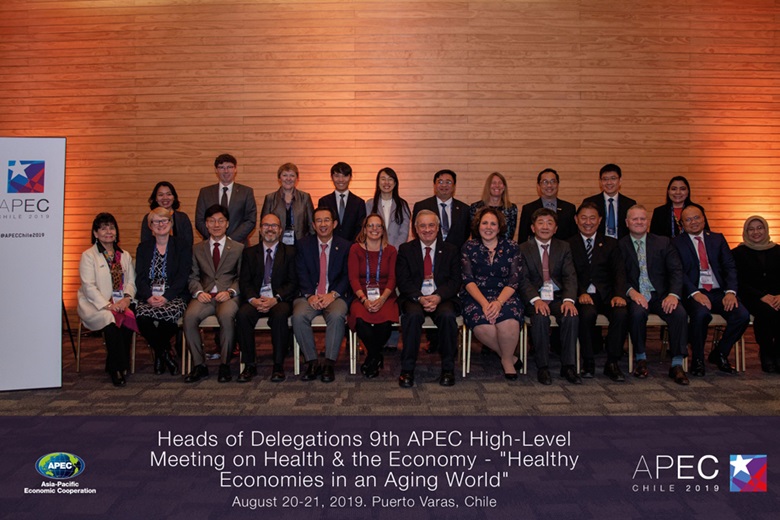2019 APEC High Level Meeting on Health and the Economy

9th APEC High-Level Meeting on Health and the Economy Joint Statement
“Healthy Economies in an Aging World”
August 20-21, 2019 | Puerto Varas, Chile
The 9th APEC High-Level Meeting on Health and the Economy (HLM9) explored the opportunities and challenges that aging populations present in enabling sustainable economic growth and development across economies.
We welcomed Chile’s theme for 2019, “Connecting People, Building the Future”, and particularly Chile’s priorities “Women, SMEs and Inclusive Growth” and “Digital Society”. Inclusive economic growth relies on healthy populations and addresses the challenges of an aging world, while new technologies contribute to the development of innovative and efficient digital solutions that favor healthy societies and economies.
APEC economies include the most rapidly aging populations in the world, a demographic change that has implications for sustainable economic growth and development. HLM9 highlighted the positive social and economic impacts associated with the active participation of older persons in the economy. HLM9 also recognized that the promotion of “Healthy Aging” is critical for mitigating the added health burden and costs associated with an aging population. Additionally, APEC economies recognized that optimizing opportunities for good health at all stages of life is necessary to facilitate healthy aging, promote the health and well-being of older people, and ensure economic growth across society for all citizens.
PROMOTING HEALTHY AGING IN THE APEC REGION
APEC economies recognized the value of effectively addressing the needs of aging populations in order to work towards the Sustainable Development Goals (SDGs), and achieve the Healthy-Asia Pacific 2020 Initiative’s to develop sustainable and high-performing health systems by integrating health into all policies and considering health across the life course. As the aging of populations accelerates, integrated care[1] and people-centered approaches are critical to ensuring the optimal well-being of an aging population and encouraging healthy aging. However, APEC economies have not seen optimal transformation of health systems to achieve this goal. HLM9 underscored the importance of considering the needs of older persons when pursuing UHC.
HLM9 recognized prevention as a key driver of healthy aging across the life course to address the many health conditions, social determinants and economic costs, that affect the later part of a person’s life. Prevention programs, which include screening, advice for active lifestyles and good nutrition, smoking cessation, reduction of alcohol-related harms and immunization, particularly adult vaccines, have an important role to play in ensuring older persons can remain active contributors to the economy and maintain their functional ability as they age. APEC economies also emphasized the role of prevention and care in supporting the 71 million people projected to have dementia in the Asia-Pacific by the year 2050[2]. With an estimated cost of US$ 182 billion, HLM9 reaffirmed the need to increase funding for dementia research, to share knowledge and best practices in the region, and the incorporation of care provider experiences when developing dementia policies. HLM9 also highlighted the importance of integrating preventative approaches and creating age-friendly environments across a variety of sectors in addition to health, including long-term care, elder home care, transportation, housing, labor, and social protection and support.
APEC economies also stressed that health care systems should support healthy aging by preventing of the spread of infectious diseases, which affect older individuals disproportionally. HLM9 reaffirmed vaccination across the life course as a pillar of preventative healthcare, noting that vaccination prevents illnesses, enabling populations to remain healthy, and reduces related expenditures over time.
HLM9 acknowledged that older populations may run into challenges that can affect their health and quality of life, including financial insecurity, loneliness, social isolation and mental distress, and noted the importance of promoting and protecting the mental health and wellbeing of older persons through a multi-disciplinary and multi-sectoral approach.
HLM9 reiterated the need to ensure sufficient and sustainable domestic public spending on health care in light of the increasing burden of disease and aging populations in APEC economies. Elder care and, in particular, home care, should be considered as an investment to support continued independence and reduce spending on the aged. HLM9 reaffirmed the need for a whole-of-government and multisector approach and welcomed the continued collaboration between APEC Finance Ministers and the APEC Business Advisory Council to share best practices, better quantify the value of innovative medicines, and explore innovative health financing solutions and partnerships.
HLM9 recognized the value of aligning APEC’s work on healthy aging with the broader global health agenda and reaffirmed the importance of continued partnership and collaboration with other multilateral fora, civil society organizations, the private sector, and other partners.
LOOKING AHEAD
HLM9 recognized that the exchange of international and APEC region experiences and best practices helps to shape and inform innovative policies and public services that not only improve health systems, but help entire economies adapt to an aging population.
[1] Integrated Care is defined as health care that is managed and delivered in a way that ensures people receive a continuum of health promotion, disease prevention, diagnosis, treatment, disease management, rehabilitation and palliative care services, at the different levels and sites of care within the health system, and according to their needs, throughout their whole life.
[2] Alzheimer’s Disease International, Alzheimer’s Australia. Dementia in the Asia Pacific Region [Internet]. London: 2014. P.64. Available from: Alzheimer’s Disease International; https://www.alz.co.uk/adi/pdf/Dementia-Asia-Pacific-2014.pdf

